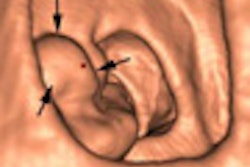VIENNA - A five-year study presented Sunday at the 2008 European Congress of Radiology (ECR) spotlighted the importance of x-ray dose optimization for computed radiography (CR) systems, particularly when converting to CR from conventional film-screen equipment.
The finding that unchecked CR doses in digital systems can escalate above required levels (and accepted international standards) has already led to an update in legislation and official National Radiation Dose Levels (NRDLs) in Luxembourg. Dr. Alexandra Schreiner, from the country's Ministry of Health, said the risks of unnecessarily high radiation doses are highest for children.
"The increase in risk is proportional to the increase in effective dose received by the patient," she said. "As far as the dose is concerned, the ALARA (as low as reasonably achievable) principle should always be applied if we want to work in an ethically correct manner, while dose reference levels should also be respected as far as legislation is concerned."
A videographic comparison of chest, pelvis, and lumbar spine x-rays following the conversion of three Luxembourg hospitals from film-screen to digital radiography revealed notable increases in entrance surface dose levels. However, the researchers warned that such changes go undetected by observers, radiographers, and physicians.
"Whereas if the dose increases on a film-screen system, it is immediately apparent, as the film will have a higher optical density and will become darker," Schreiner said. "The major risk with CR is that an increase in dose may pass unnoticed since it does not decrease image quality. For this reason, it is important that the CR system has a detector dose indicator and that the user be educated to look at it regularly."
By using automated quality control software for constancy testing and implementing protocols for acceptance testing and dose optimization, Schreiner's team reduced radiation doses significantly in areas where they were elevated. The NRDL for chest radiation was lowered by 20%, by 40% for the pelvis, and by 20% for the lumbar spine AP.
After optimization, CR radiation not only fell back from the elevated levels but dropped below the original levels as measured on conventional film-screen machines.
European legislation had earlier recorded a dose reference level for pelvis x-rays of 10 mGy; whereas after the dose-optimization program was implemented, CR was able to run successfully at just 5.85 mGy.
On the basis of these findings, Schreiner's dose-optimization work was rolled out in all hospitals across Luxembourg, supporting their switch to CR.
In devising the optimization protocols, the team referenced several U.S. and European reports on acceptance testing, constancy testing, and evaluating diagnostic processes. Digital radiography performance appraisal procedures, as compiled by the King's Centre for the Assessment of Radiological Equipment (KCARE) in London, were deemed to be "very efficient."
However, regular CR evaluation is required to ensure continued optimal performance, Schreiner added. Acceptance testing should be performed upon receipt of a new system, or when major components are changed, especially if they can influence dose or image quality.
Thereafter, a yearly quality control check by a medical physicist is recommended, while a radiographer should implement a monthly constancy test. This, it was concluded, would "ensure the best image quality with as low a dose as is achievable, as well as the safety of the patient."
CT radiation risk
In a separate study presented at ECR, Dr. Koos Geleijns of Leiden University Medical Center in the Netherlands provided a counterargument to recent studies criticizing the risks of radiation exposure in some radiology exams, such as CT angiography. Geleijns criticized current approaches for radiation risk assessment for focusing on single risk factors, and therefore being "inaccurate."
Discussing the failure to take into account short-term complications (including mortality) for disease and treatment, he said that common protocols underestimate these risks while overestimating radiation risk.
Geleijns proposed instead the use of a series of multiple-decrement "life tables," representing age- and gender-related functions pertaining to mortality, which integrate all relevant characteristics and risk factors for specific patient populations.
This method was applied in the study to coronary artery disease (CAD) diagnosis and follow-up of endovascular abdominal aortic aneurysm (AAA) repair. Mortality from radiation exposure and excess mortality from diseases and complications were included. Long-term mortality related to radiation exposure was estimated using the BEIR VII risk model. All risks were expressed as a reduction of life expectancy.
Results revealed that under clinical conditions the acute risk of mortality from cardiac catheterization in coronary artery disease was small (at 0.1%), yet it substantially exceeds radiation risks from either CAD (5 mSv) or coronary CT angiography (15 mSv).
High disease-related mortality associated with AAA (6% per year) far exceeds the radiation risks from CT follow-up (18 mSv/year), and also substantially lowers estimates of radiation risk when compared to current evaluative methodologies.
"We used the excess relative risk model, and the radiation risk is expressed relative to the background cancer risks," Geleijns noted. "With regard to the cancer risks, we looked at several organ groups as defined by the BEIR VII report."
Based on the results, the researchers recommend a comprehensive risk assessment be performed by using multiple-decrement life tables that integrate long- and short-term excess mortality. The next step is "to also include in the models the benefit and diagnosis and following treatment," Geleijns said.
By Rob Skelding
AuntMinnie.com contributing writer
March 9, 2008
Related Reading
AAPM offers report on CT radiation reduction, February 19, 2008
ACR responds to NEJM article on CT radiation risks, November 29, 2007
Increased use of CT scans raises risk of higher radiation exposures, November 20, 2007
Studies examine digital methods for reducing pediatric x-ray dose, October 9, 2007
PACS data-mining technique tackles CR dose creep, July 30, 2007
Copyright © 2008 AuntMinnie.com



















